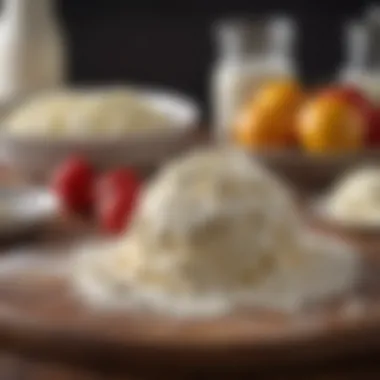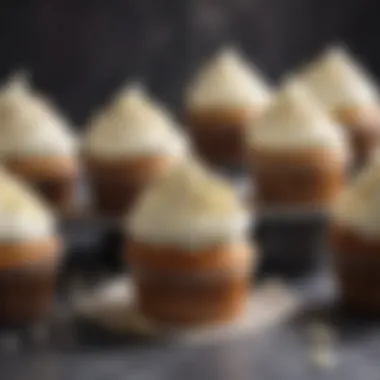Crafting Cream Cheese Icing from Scratch: A Complete Guide


Intro
Crafting a delightful cream cheese icing from scratch is an essential skill for bakers of all levels. This frosting boasts a rich flavor and creamy texture, making it an ideal accompaniment to various desserts, from carrot cake to red velvet cupcakes. Understanding the nuances of this icing can elevate your baking and impress those who indulge in your creations.
The process of making cream cheese icing is straightforward, but several factors can influence the final product. Attention to detail from ingredient selection to mixing techniques plays a vital role. This guide will methodically break down each aspect, ensuring you have the tools necessary to achieve perfect consistency and flavor every time.
Recipe Overview
- Recipe name: Classic Cream Cheese Icing
- Brief description of the dish: This icing features a harmonious blend of cream cheese and butter, delicately sweetened and flavored, creating a velvety finish that enhances any baked good.
Ingredients List
The success of your cream cheese icing largely depends on the quality of the ingredients you use. Here’s what you will need:
Main ingredients
- Cream Cheese: Full-fat cream cheese is essential for a rich and creamy texture.
- Unsalted Butter: This adds richness and helps achieve the right consistency.
- Powdered Sugar: This sweetens the icing without making it grainy.
- Vanilla Extract: A hint of vanilla enhances the overall flavor.
Optional ingredients
- Lemon Juice: For a tangy twist, a small amount of lemon juice can brighten up the flavor.
- Cocoa Powder: For chocolate lovers, adding cocoa can create a chocolate cream cheese icing.
By integrating these ingredients thoughtfully, you will create a frosting that is not only delightful but also versatile. Whether you frost a cake or dip cookies, understanding each component’s role is crucial for achieving the best results.
Understanding the Basics of Cream Cheese Icing
Understanding cream cheese icing sets a solid foundation for crafting this popular frosting from scratch. It is essential to grasp its role in various culinary contexts, from enhancing baked goods to personalizing dessert experiences. Knowing the fundamentals not only helps in creating a delectable icing but also in exploring its versatility and applications.
What Is Cream Cheese Icing?
Cream cheese icing is a smooth frosting made primarily from cream cheese, butter, and sugar. This unique blend yields a tangy flavor profile, distinguished from conventional buttercream. It typically presents a creamy texture, making it easy to spread or pipe onto cakes and pastries. The tanginess of cream cheese balances the sweetness, creating a pleasing flavor that can enhance many dessert types. It is a favorite topping for carrot cakes, red velvet cakes, and various cupcakes. The icing can also be adapted to suit different flavor preferences, adding versatility.
Common Uses for Cream Cheese Icing
Cream cheese icing serves multiple purposes in baking. Its primary function is as a frosting for cakes and cupcakes. Notably, it pairs well with flavors like carrot, lemon, and chocolate. However, its uses extend beyond traditional baking:
- Filling for pastries: Adding a layer of cream cheese icing between cake layers or pastries enhances taste and texture.
- Dip for fruits: A sweet dip for fruits like strawberries and apple slices can be prepared, adding an enjoyable dimension to healthy snacks.
- Spread for bagels or toast: Mixed with herbs or spices, it can be an excellent savory spread, offering a new twist on breakfast favorites.
These applications highlight the adaptability of cream cheese icing in both sweet and savory dishes, making it a staple in many kitchens.
Nutritional Aspects of Cream Cheese
When delving into the nutritional aspects of cream cheese, it becomes evident that this ingredient brings both benefits and considerations. Cream cheese contains certain nutrients like calcium and vitamin A, but it is also important to consider its fat and calorie content. For example:
- Calories: Cream cheese typically holds a higher calorie count than some other icing options, primarily due to its fat content.
- Fat content: While cream cheese provides some saturated fat, it can be part of a balanced diet when consumed in moderation.
- Potential alternatives: For those seeking lower-calorie options, reduced-fat cream cheese or vegan alternatives can be explored, although the flavor and texture may slightly differ.
Understanding these nutritional details aids in making informed choices while allowing for creative flexibility in recipes.
Essential Ingredients for Cream Cheese Icing
Understanding the essential ingredients for cream cheese icing is crucial in achieving the desired flavor, texture, and stability. Each component plays a vital role in the final outcome. By selecting high-quality ingredients, one can significantly enhance the taste and overall appeal of the icing. Additionally, recognizing the function of each ingredient allows bakers to adjust their recipes according to personal preferences or dietary restrictions.
Selecting Quality Cream Cheese
Quality cream cheese is the foundation of great icing. The texture and flavor of the icing depend largely on the cream cheese used. It is advisable to select a full-fat cream cheese for better creaminess and reduced water content. Processed or low-fat varieties may lead to a thinner consistency that does not hold up well when spread or piped. When shopping, look for brands that specify 'cream cheese' as the main ingredient without fillers or additives. This ensures a rich and tangy flavor that is characteristic of traditional cream cheese icing.
The Role of Butter in Icing


Butter contributes to the flavor and richness of cream cheese icing. It helps to create a smooth texture and adds a creamy element that balances the tanginess of the cream cheese. Using unsalted butter is recommended, as it allows for control over sodium levels. Room temperature butter mixes well with cream cheese, creating a homogenous blend. However, one must be cautious not to overmix, as this can introduce excess air, resulting in a lighter and potentially unstable icing.
Choosing the Right Sugar Type
Sugar types can influence both the taste and texture of the icing. Granulated sugar is commonly used, but confectioners’ sugar is preferred for its fine consistency, which dissolves easily in the mixture. This leads to a smoother texture that is essential for a pleasing mouthfeel. Some bakers may experiment with alternatives like powdered coconut sugar or agave syrup, though these may alter the flavor profile and consistency.
Incorporating Flavorings and Spices
Flavorings and spices can enhance the cream cheese icing further, making it unique and tailored to specific desserts. Vanilla extract is a classic choice that complements the creaminess. However, other flavorings like almond extract or citrus zest can provide a refreshing twist. When incorporating spices, options such as cinnamon or nutmeg can add warmth and depth. These elements should be added gradually and adjusted to taste to maintain balance in flavor.
Tools and Equipment Needed
To successfully craft cream cheese icing from scratch, it is essential to have the right tools and equipment. The proper instruments not only contribute to the cleanliness and efficiency of the baking process but also play a crucial role in achieving the desired texture and consistency of the icing. This section will discuss the necessary tools, their functions, and considerations when selecting them.
Essential Mixing Tools
Mixing tools are vital for ensuring that the ingredients blend smoothly. One of the primary tools needed is a hand mixer or a stand mixer. These devices effectively combine cream cheese and butter, which is fundamental to the icing. Using a hand mixer allows for greater control over mixing and can be preferable for small batches. On the other hand, a stand mixer can handle larger quantities with ease.
When choosing your mixing tools, consider the following:
- Comfort: An ergonomic design can significantly reduce fatigue during mixing, especially in larger batches.
- Speed Settings: Multiple speed settings on a mixer can provide versatility, adapting to various icing consistencies.
- Attachments: Different mixing attachments, like beaters or paddles, can alter the texture of the icing.
Additionally, a spatula is necessary for scraping down the sides of the mixing bowl and ensuring all ingredients are evenly incorporated. Using a rubber spatula helps in getting every bit of icing from the bowl—no waste.
Importance of Accurate Measuring Devices
Measuring devices are often overlooked, but they are critical in the process of making cream cheese icing. Accurate measurements ensure the right balance between the ingredients, directly affecting the flavor and texture of the icing.
Investing in high-quality measuring cups and spoons is advisable. Here are some reasons why accurate measuring devices are important:
- Consistency: Using the same measurements each time results in consistent flavor and texture, essential for repeatability in recipes.
- Error Reduction: Accurate measuring reduces the likelihood of mistakes that could lead to overly sweet or runny icing.
- Recipe Fidelity: Many recipes rely on specific ratios of ingredients. Deviating from these can lead to unsatisfactory results.
Utilizing both dry and liquid measuring cups ensures that each component, whether it is sugar or melted butter, is measured correctly. For precise measurements, digital kitchen scales can provide additional accuracy. This is especially useful when dealing with butter or cream cheese that might need to be weighed rather than measured by volume.
Remember, precision in the kitchen creates delicious results. Always double-check your measurements before mixing.
Step-by-Step Process for Making Cream Cheese Icing
Understanding the step-by-step process for making cream cheese icing is crucial for achieving the perfect texture and flavor. This section breaks down each stage, providing bakers of all skill levels with a systematic approach. Following this method ensures consistency in results, which is particularly important when using cream cheese icing for various desserts.
Preparing Ingredients
Before beginning, it is essential to prepare all ingredients. Gather quality cream cheese, unsalted butter, powdered sugar, and any flavorings you wish to use. Measure them out in advance to ensure you have everything on hand. This preparation not only saves time but helps in maintaining a smooth workflow during the mixing process. Make sure the cream cheese and butter are at room temperature. This allows them to blend more easily, resulting in a smooth icing.
Mixing Cream Cheese and Butter
Start by creaming the softened cream cheese with the butter in a large mixing bowl. Use an electric mixer on medium speed to achieve a light and fluffy consistency. This step is important as it incorporates air into the mixture, contributing to a lighter icing. Ensure that the mixture is homogeneous with no lumps remaining. A thoroughly blended base is key to a successful final product.
Incorporating Sugar Gradually
Once the cream cheese and butter are well combined, the next step is to add powdered sugar gradually. It is advisable to add sugar in small amounts, mixing well after each addition. This prevents a sugar cloud from forming, which often happens if sugar is added too quickly. Gradual incorporation also helps control the sweetness of the icing. Taste as you mix to find the ideal level of sweetness that complements your dessert.
Adding Flavorings and Achieving Desired Consistency
After the sugar is well mixed in, it’s time to add any desired flavorings such as vanilla extract or lemon zest. Again, mix carefully until fully combined. Adjusting the consistency is vital at this stage. If the icing seems too thick, a splash of milk can help reach a smoother texture. Conversely, if it’s too thin, continue adding powdered sugar until it is just right. The ideal cream cheese icing should be spreadable yet hold its shape well when piped.
"A well-executed icing can elevate even the simplest dessert to gourmet status."


By carefully following these steps, bakers can ensure that their cream cheese icing not only tastes great but also looks appealing. This step-by-step approach is foundational for creating an exceptional icing that will impress anyone.
Customization Options for Cream Cheese Icing
Customization options for cream cheese icing are essential for creating a product that meets diverse taste and dietary preferences. This section dives into various ways to tweak flavors, enhance colors, and meet specific dietary requirements. Understanding these options allows both novice and seasoned bakers to craft a more personalized icing, enriching the overall baking experience.
Variations by Flavor Profiles
Flavor is a crucial aspect of cream cheese icing. While the classic version is undeniably delicious, exploring different flavor profiles can elevate your creations. Adding elements such as vanilla extract, almond flavoring, or even citrus zest can enhance the icing, giving it a distinct twist.
Some popular flavor variations include:
- Chocolate: Incorporating cocoa powder or melted chocolate creates a rich chocolate cream cheese icing.
- Fruit-based Options: Adding pureed strawberries, raspberries, or lemon juice delivers a refreshing taste and pairs well with light cakes.
- Spices: Experimenting with cinnamon or nutmeg, particularly in fall-inspired recipes, can add depth and warmth to the icing.
These flavor variations allow bakers to adapt the icing to suit specific cakes or personal tastes, making it a versatile choice for various desserts.
Coloring Your Icing
Coloring can transform the appearance of cream cheese icing, making it visually appealing for different occasions. Food colorings, available in both liquid and gel forms, can easily be blended into the icing for stunning results. Selecting appropriate colors can make your cakes stand out at events such as birthdays, holidays, or weddings.
To color your icing effectively, consider the following:
- Gel Colors: Gel food coloring provides more vibrant hues and requires less product, ensuring that the icing does not become overly runny.
- Natural Options: For those seeking a healthier choice, natural colorants derived from fruits, vegetables, or spices can offer beautiful shades without artificial additives.
Importantly, always add color gradually and mix thoroughly to achieve the desired shade while keeping the icing's consistency intact.
Gluten-Free and Vegan Alternatives
As dietary preferences evolve, providing gluten-free and vegan alternatives for cream cheese icing is increasingly relevant. Adapting this icing allows more individuals to enjoy the delight of cake frosting without compromising their food restrictions.
For gluten-free options, ensure that all ingredients used, including the sugars and flavorings, are certified gluten-free. Substituting ingredients like regular cream cheese with products made from almond or cashew nuts offers a vegan alternative.
Some useful combinations include:
- Vegan Cream Cheese: Brands like Tofutti and Kite Hill offer excellent substitutes that mimic the texture and taste of traditional cream cheese.
- Butter Replacements: Using coconut oil or vegan margarine can help achieve the desired creaminess.
Customizing cream cheese icing for different dietary needs not only broadens its appeal but also embraces inclusivity in baking. With these options, anyone can indulge in a delicious icing, enhancing their culinary experiences.
Tips for Perfecting the Icing
Mastering cream cheese icing involves attention to detail and practice. Understanding critical aspects can lead to a consistently delicious frosting. Here are some key elements that can help improve your icing skills and ensure satisfaction with every batch.
Avoiding Common Mistakes
A few missteps can ruin an otherwise perfect cream cheese icing. Here are some common mistakes to avoid:
- Using Cold Ingredients: Cold cream cheese or butter can lead to lumps in your icing. Always let them come to room temperature before mixing.
- Overmixing: While you want to achieve a smooth texture, overmixing can cause the icing to become thin, losing its structure. Mix just until everything is well-blended.
- Not Tasting as You Go: Failing to taste your icing during preparation can lead to a final product that is overly sweet or lacks flavor. Regularly sample your icing and adjust as needed.
- Ignoring Texture: The consistency is crucial for the intended use. If your icing is too thin for spreading, it may drip off your cake, while too thick icing may not spread easily.
In summary, being mindful of these details can elevate your icing game and enhance your overall baking experience.
Adjusting Consistency for Different Applications
Getting the consistency right is essential for different uses of cream cheese icing. Here are some considerations for various applications:
- Thick Consistency for Spreading: If you're frosting cakes, aim for a thick icing. This consistency helps in creating smooth finishes and decorative swirls.
- Medium Consistency for Piping: For piping decorative borders or roses, allow the icing to be slightly softer but still hold its shape. You can adjust the thickness by adding a little milk or more powdered sugar.
- Thin Consistency for Drizzling: If you're using the icing for drizzling or filling, add milk gradually to achieve a thinner texture. This allows it to flow easily and cover surfaces evenly.
When adjusting, always remember to incorporate small amounts until you reach your desired texture.


Tip: Document your adjustments. Keeping notes will help you replicate the perfect consistency in your future baking ventures.
Application Techniques for Cream Cheese Icing
Application techniques are essential when working with cream cheese icing, as they can determine the final presentation and taste experience of your baked goods. Mastering these techniques ensures not only a visually appealing result but also an appropriate amount of sweetness and texture that complements various desserts. Knowing how to apply cream cheese icing correctly allows one to elevate their baking to a more professional level.
Frosting Cakes with Precision
Frosting cakes with precision is crucial for achieving a uniform and polished appearance. When preparing to frost, begin with a cooled cake. This ensures that the icing does not melt and slide off. Here are key steps to consider:
- Leveling the Cake: Use a serrated knife to slice off the dome of the cake. This creates a flat surface, making it easier to apply icing evenly.
- Crumb Coat: Apply a thin layer of icing over the entire cake. This crumb coat seals in crumbs and provides a smooth base for the final layer of icing. After applying this coat, refrigerate the cake briefly to set it.
- Icing Application: Use an offset spatula or a bench scraper to spread the cream cheese icing over the top and sides of the cake. While smoothing, maintain even pressure to avoid pulling crumbs from the cake.
By achieving a clean finish with these techniques, the cake will not only taste delightful but also look professionally crafted.
Piping Techniques for Decorative Finishes
Piping is an art form in itself and adds an appealing finish to your desserts. Understanding different piping techniques can enhance the aesthetics of your cream cheese frosting significantly. Here are some key aspects to consider when piping:
- Choosing the Right Tip: Piping tips come in various shapes and sizes. For example, a star tip can create scalloped edges, while a round tip is ideal for writing or dots.
- Consistent Pressure: When piping, maintaining a steady hand and consistent pressure is vital. Practice on parchment paper before working on your actual cake to avoid mistakes.
- Decorative Techniques: You can create rosettes, shells, or even borders. Experimenting with pressure and speed will result in different styles, making your cakes uniquely personal.
Utilizing these piping techniques allows you to transform the simplest cake into a stunning centerpiece, showcasing both skill and creativity.
"The right techniques not only enhance appearance but also elevate the overall dessert experience for every recipient."
Focusing on these application methods will refine your baking skills, enabling you to create cakes that are not just good to eat, but also a joy to behold.
Storage Guidelines for Cream Cheese Icing
Storing cream cheese icing properly is essential for both maintaining its quality and ensuring safety. Cream cheese icing, like many dairy-based products, is prone to spoilage if not handled correctly. Understanding how to store this icing can help bakers make the most of their efforts and minimize waste. In this section, we will discuss effective strategies for both short-term and long-term storage, along with best practices to keep the icing fresh.
Short-Term vs Long-Term Storage
When it comes to storage, it's important to recognize the differences between short-term and long-term options. Short-term storage refers to keeping cream cheese icing just for a few days, generally in the refrigerator. This allows the icing to remain usable and delicious without significant decline in quality. Store the icing in an airtight container to avoid absorbing any odors from the fridge and prevent the icing from drying out. It's advisable to use it within one week for the best taste.
On the other hand, long-term storage involves freezing the icing. Freezing can extend the shelf life effectively up to three months. To do this, place the icing in a freezer-safe container. You can also use a freezer bag, squeezing out as much air as possible before sealing. When ready to use, thaw the icing in the refrigerator overnight. Once thawed, it may require a quick remix to regain its original texture.
Best Practices to Maintain Freshness
To maximize freshness during storage, certain practices should be adhered to. Here are key guidelines:
- Use clean utensils: Always use clean, dry utensils when scooping out icing to prevent contamination.
- Label your storage containers: Mark your containers with the date of preparation. This will help track freshness and reduce waste.
- Keep at proper temperature: Always store cream cheese icing in the refrigerator or freezer, depending on your needs, to minimize the risk of spoilage.
- Check for signs of spoilage: Before use, examine the icing for any off odors, discoloration, or visible mold. If any of these are present, it is best to dispose of the icing.
Remember: Proper storage isn't just about extending shelf life; it also ensures that each application of cream cheese icing meets your high standards of flavor and texture.
Closure
By summarizing the essential points discussed throughout the article, you remind readers of the various elements crucial for making perfect icing. From selecting high-quality ingredients to mastering application techniques, every consideration plays a role in achieving the desired result.
"Innovation in baking occurs at the intersection of basic techniques and personal flair."
The benefits of understanding these components include improved baking skills and the ability to experiment with flavors and textures. When readers grasp these concepts, they feel more confident in their baking endeavors.
Overall, the importance of this conclusion lies in encouraging bakers to utilize the knowledge gained. Experimentation with cream cheese icing can lead to unique combinations and personal touches that enhance any baking project. This not only fulfills creative outlets but also brings joy to anyone who tastes the final products.
Summary of Key Points
- Ingredients Matter: Quality ingredients are essential for optimal flavor and texture.
- Technique is Key: Mastering mixing methods can significantly impact the consistence of the icing.
- Customization and Creativity: There are many ways to adapt the recipe to suit different tastes and dietary needs.
- Storage Considerations: Proper storage ensures icing freshness and flavor longevity.
Encouragement for Experimentation
Baking is as much about tradition as it is about creativity. I encourage readers to take the foundational knowledge provided in this article and expand upon it. Try different combinations of flavors, such as lemon zest or vanilla bean, to make the icing more unique.
Consider also substituting traditional ingredients to accommodate dietary restrictions. Options like vegan cream cheese or alternative sweeteners can lead to delightful variations that surprise and please.
Remember, cooking is a practice that benefits from open-mindedness. Embrace the opportunity to experiment, allowing personal preferences to guide your choices. Not every attempt will yield perfection, but each one is a stepping stone toward improving your craft.







